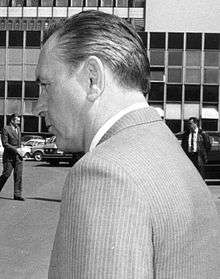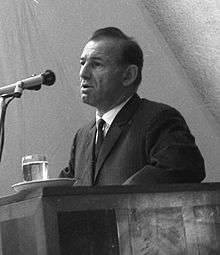Hungarian Socialist Workers' Party
The Hungarian Socialist Workers' Party (Hungarian: Magyar Szocialista Munkáspárt, MSzMP) was the ruling Marxist–Leninist[1] party of the Hungarian People's Republic between 1956 and 1989. It was organised from elements of the Hungarian Working People's Party during the Hungarian Revolution of 1956, with János Kádár as general secretary. The party also controlled its armed forces, the Hungarian People's Army.
Hungarian Socialist Workers' Party Magyar Szocialista Munkáspárt | |
|---|---|
.svg.png) | |
| First leader | János Kádár |
| Last leader | Rezső Nyers |
| Founded | 31 October 1956 |
| Dissolved | 7 October 1989 |
| Preceded by | Hungarian Working People's Party |
| Succeeded by | Hungarian Socialist Party, Hungarian Communist Workers' Party |
| Headquarters | Budapest, Hungarian People's Republic |
| Newspaper | Népszabadság |
| Youth wing | Hungarian Young Communist League |
| Armed wing | Workers' Militia |
| Ideology | Communism Marxism–Leninism Kádárism |
| Political position | Far-left |
| Colors | Red, white, green (Colours of the Hungarian flag) |

Like all other Eastern Bloc parties, the MSzMP was organized on the basis of democratic centralism, a principle conceived by Vladimir Lenin that entails democratic and open discussion of issues within the party followed by the requirement of total unity in upholding the agreed policies. The highest body within the MSzMP was the party Congress, which convened every five years. When the Congress was not in session, the Central Committee of the MSzMP was the highest body. Because the Central Committee met twice a year, most day-to-day duties and responsibilities were vested in the Politburo. The party leader was the head of government and held the office of either General Secretary, Premier or head of state, or some of the three offices concurrently—but never all three at the same time. The party leader was the de facto chairman of the Politburo and chief executive of Hungary.
Overview
The party supported the revolution, but turned against Imre Nagy's government after he denounced the Warsaw Pact. The party formed a 'Revolutionary Peasant-Worker Government' that took over the country, with Soviet support, on 4 November 1956.
Gradually, however, the new government instituted goulash Communism, a somewhat more humane way of governing than had prevailed under Mátyás Rákosi. Under Kádár's mantra of "he who is not against us is with us," Hungarians generally had more freedom than their Eastern Bloc counterparts to go about their daily lives. For example, his government executed only 350 people after the 1956 revolution. The government also gave limited freedom to the workings of the market via the New Economic Mechanism. However, it retained a monopoly of political power, and subjected the media to censorship that was fairly onerous by Western standards. The National Assembly, like its counterparts in the rest of the Soviet bloc, continued to rubber-stamp decisions already made by the MSzMP leadership.[2]
Kádár retired on 22 May 1988 and was succeeded by Prime Minister Károly Grósz. However, Grósz soon found himself eclipsed by a group of radical reformers who favored establishing a market economy. On 28 January 1989, young Politburo member and minister of state Imre Pozsgay announced during an interview with the radio program 168 Hours that the Poliburo's historical sub-committee regarded the events of 1956 as a 'people's uprising'. This announcement, not approved in advance by the Politburo, provoked and catalyzed various developments within the party, and brought about sudden and ever-escalating changes that, within nine months, resulted in the ending of Communism in Hungary and the dissolution of the MSzMP.[3]
By the summer of 1989, the MSzMP was no longer a Marxist–Leninist party, and the radical reformers, led by Prime Minister Miklós Németh, Foreign Minister Gyula Horn, Rezső Nyers, and Pozsgay, had taken over the party machinery. On 26 June 1989, the Central Committee was renamed the Political Executive Committee, and the Politburo was replaced by a four-man collective presidency chaired by Nyers. Although Grósz remained general secretary, Nyers now outranked him. On 7 October 1989 the MSzMP was dissolved and refounded as the Hungarian Socialist Party, a Western-style social democratic party. Two weeks later, the National Assembly approved numerous amendments to the constitution that purged it of its Marxist–Leninist character, ending one-party rule in Hungary.
A small Communist faction, centred on Károly Grósz, opposed these reforms and broke away to form the Hungarian Communist Workers' Party on 17 December 1989.
Leaders of the Hungarian Socialist Workers' Party
First/General Secretaries
| No. | Picture | Name (Birth–Death) |
Term of Office | Position(s) | Notes | |
|---|---|---|---|---|---|---|
| 1 | .jpg) |
János Kádár (1912–1989) |
1 November 1956[4] | 22 May 1988 | First Secretary | Also Prime Minister (1956–1958 and 1961–1965) |
| General Secretary
(from 28 March 1985) | ||||||
| 2 |  |
Károly Grósz (1930–1996) |
22 May 1988 | 26 June 1989[5] | Also Prime Minister (1987–1988) | |
Chairman of the Presidency of the Political Executive Committee
| No. | Picture | Name (Birth–Death) |
Term of Office | Position(s) | |
|---|---|---|---|---|---|
| 1 |  |
Rezső Nyers(1923–2018) | 26 June 1989 | 7 October 1989 | Party President[6] |
Electoral history
National Assembly elections
| Election | Party leader | Votes | % | Seats | +/– | Position | Government |
|---|---|---|---|---|---|---|---|
| 1958 | János Kádár | as part of HFN | 276 / 338 |
Sole legal party | |||
| 1963 | 252 / 298 |
Sole legal party | |||||
| 1967 | 259 / 349 |
Sole legal party | |||||
| 1971 | 224 / 352 |
Sole legal party | |||||
| 1975 | 215 / 352 |
Sole legal party | |||||
| 1980 | 252 / 352 |
Sole legal party | |||||
| 1985 | 288 / 387 |
Sole legal party | |||||
See also
References
- "Hungary - Ideology". www.country-data.com. Retrieved 4 April 2017.
- Sebetsyen, Victor (2009). Revolution 1989: The Fall of the Soviet Empire. New York City: Pantheon Books. ISBN 0-375-42532-2.
- "Archived copy". Archived from the original on 4 March 2016. Retrieved 28 September 2012.CS1 maint: archived copy as title (link)
- Previously First Secretary of the disbanded Hungarian Working People's Party 25–30 October 1956.
- Continued as general secretary until 7 October 1989 but outranked by Rezső Nyers, the Chairman of the 4-man Presidency of the newly created Political Executive Committee which replaced the Politburo after 26 June 1989.
- While Grósz retained the title of General Secretary until 7 October, Nyers held the chairmanship of the Party's four-man presidency after the reorganization of the Party leadership on 26 June. This made him de facto chief executive of both the Party and the country after that date for several months in 1989.